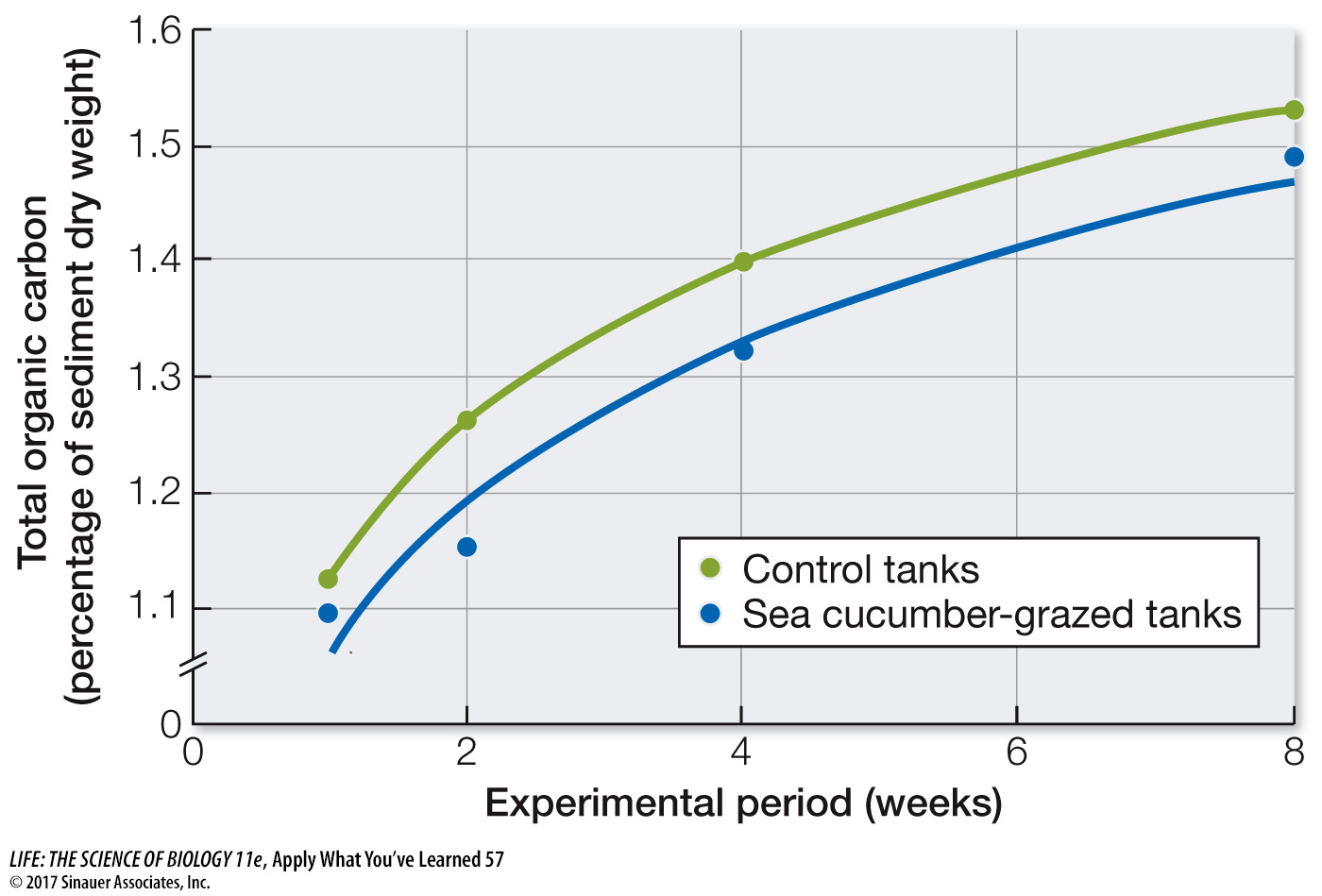Apply What You’ve Learned
Review
57.1
Autotrophs and heterotrophs obtain required nutrients in different ways.
57.2
Primary production in aquatic systems is limited by light (which is limited by depth) and by the availability of different nutrients, depending on the type of system.
57.3
Omnivory and the number of trophic levels affect the transfer of energy through food webs.
57.4
Decomposition and mineralization are necessary to complete nutrient cycling in ecosystems.
57.5
Alteration of ecosystems for human benefits involves trade-
57.5
To develop more sustainable use of ecosystems, the value of ecosystem services must be measured.
Original Paper: Slater, M. J. and A. G. Carton. 2009. Effect of sea cucumber (Australostichopus mollis) grazing on coastal sediments impacted by mussel farm deposition. Marine Pollution Bulletin 58: 1123−1129.
Some coastal marine ecosystems receive excess organic matter from aquaculture farms. This can concentrate organic matter in the sediment and decrease oxygen, leading to hypoxia. Scientists believe that benthic organisms, such as sea cucumbers, might help mitigate this potentially detrimental effect. Sea cucumbers feed on sediments containing bacteria, benthic marine algae, and the feces of cultured species; thus they recycle organic matter and alter nutrient fluxes in the ecosystem. They also disturb sediments, causing some amount of mixing with the water column above.
Researchers studied the effects of sea cucumber grazing on the chemistry of sediments produced by cultured mussels, filter feeders on phytoplankton. The researchers set up 16 experimental tanks with flowing filtered seawater. Three tanks were maintained as controls, with no grazing, and one tank was kept as a water filtration control. Each of the other 12 tanks housed a single sea cucumber, which was fed a specific amount of mussel-
The graph shows the results of tests for total organic carbon (TOC). TOC measures all organic carbon including live and dead matter and not including CO2 released from metabolism. It is sometimes used to measure organic pollution from sewage or agriculture.

Questions
1.
How would you describe the position of sea cucumbers in the marine benthic food web? How might their position affect net primary production (NPP) through this ecosystem?
Sea cucumbers feed on bacteria, benthic marine algae, and decaying organic matter such as feces. Thus they are omnivores, feeding from several levels in the food web. They are also decomposers because they feed on decaying organic matter. Their effect on NPP is hard to predict. By feeding on both primary producers and consumers, sea cucumbers may have little effect on NPP. Bacteria are also decomposers, so sea cucumbers may be feeding on a competitor.
2.
Based on the graph, what can you conclude about the effect of sea cucumbers on the amount of TOC in sediments? How is this effect related to nutrient cycling?
According to the graph, TOC increases steadily over the 8-
3.
Why do you think TOC (see graph) continues to increase over the course of the experiment? How does this increase relate to the activities of sea cucumbers?
There are at least two reasons why TOC continues to increase. First, a specific amount of mussel feces containing TOC is added each day (mirroring, albeit experimentally, what would happen in a mussel farm). Second, as this organic waste is added, bacteria increase as they feed on and decompose the waste. Both waste (dead organic matter) and bacterial biomass (live organic matter) are included in the TOC value. The experiment shows that TOC begins to level off as the experiment proceeds. For the control treatment (black circles) this likely means that, after an initial rise in bacterial population size, the bacteria begin to suffer food limitation. This is also shown in the sea cucumber treatment (clear circles), but with the added effect of sea cucumber grazing on TOC, which includes both waste and bacteria. As sea cucumbers feed, they break down and mineralize the TOC. However, the single cucumber used per tank in these trials is insufficient to cause a significant decline in TOC. It is likely that a larger sea cucumber population would further control TOC; if that population were large enough, it could solve the hypoxia problem.
4.
A major problem in aquaculture operations such as mussel farming is hypoxia, or dangerously low levels of oxygen in the water. Given the information on TOC in this experiment, how do you think oxygen levels likely changed over the course of the experiment? What factors would cause these changes, and how does the presence of sea cucumbers affect the likelihood of hypoxia?
As TOC levels increase, bacterial levels also increase, as bacteria use TOC as a food source and decompose it. Increased bacterial activity uses up oxygen, often resulting in hypoxia. In this experiment, oxygen levels would be decreasing as TOC increases; oxygen would decrease less as TOC begins to level off. The presence of sea cucumbers would make hypoxia less likely, because they would break down TOC and bacteria. Thus as TOC levels decline, oxygen levels will increase. But in this particular experiment, there is only one sea cucumber per test aquarium. This is not sufficient to break down most of the TOC; therefore oxygen levels are still likely to be too low for a healthy ecosystem.
5.
An aquaculture manager cultures mussels in a coastal farm. He has a serious pollution problem, due to the waste his mussels release into the water, and the resulting hypoxia. He is considering whether to introduce sea cucumbers into his farm. What ecological trade-
The aquaculture manager chose to produce mussels in a natural coastal environment. This resulted in food for humans, but in the process he risked polluting the coastal environment. This is a trade-
Go to LaunchPad for the eBook, LearningCurve, animations, activities, flashcards, and additional resources and assignments.